We wrote an article about B2B marketing strategy, where we focused on the thought process when it comes to plan, execute, and prioritize marketing activities.
I won’t share a list of channels or generic ideas like “do social media” or “write blog posts.”
In this article, we will be more practical; I will share with you some of the tactics I have used or have followed to generate and convert leads (and also show you which of them have failed).
SaaS KPIs – where to focus your SaaS strategy
It’s funny when people compare email marketing and SEO, paid ads, and social media, claiming that email marketing doesn’t generate as much traffic, SEO doesn’t convert as much as paid ads, and social media doesn’t drive as much traffic as SEO—then they show why the channel they use is better.
It’s a false dichotomy – not an apples-to-apples comparison.
Each channel serves a different objective and has a different KPI to be measured.
I know there are many frameworks: the flywheel, the funnel, the buyer journey, and pirate metric (I may be missing something, but I bet it works the same).
All these frameworks describe the marketing process to convert strangers into customers.
So heads up with those gurus or experts who try to convince you that they have a magic funnel that works consistently and predictably — they’re are talking the same things but re-labeling them.
This time, I will explain the Pirate Metrics – a useful, actionable, and specific for SaaS businesses.
They’re called Pirate Metrics because the acronym AAARRR represents them.
When thinking of SaaS marketing tactics ideas, consider that they should help optimize one or more of these metrics.
Awareness

In the first stage, you want to reach people to know your site, product, or brand in general. Such reach is measured in website traffic, social media engagements, and media exposure in general.
The risk of measuring awareness metrics is that they’re underrated or overrated; they’re underrated when companies work towards generating only qualified leads ignoring that the buying process is not that linear; they’re overrated when these metrics don’t relate at all with the bottom line or sales performance, becoming vanity metrics.
If you’re wondering how they relate awareness metrics with sales, you should think you’re building an audience that you can re-target to convert eventually.
Or reach people who can influence others decision making, or thinking that, if well done, working on brand awareness and positioning should generate customers consistently through WOM.
You also will understand Awareness is essential when you acknowledge that building trust is critical to make people buy.
However, in some cases, while it’s essential to work on Awareness, maybe it shouldn’t be the channel you should prioritize in the short term. As a rule of thumb, I follow is that I wouldn’t work on Awareness if other stages like lead generation in the acquisition stage are not working yet.
Acquisition

The acquisition stage is about making people try your product for a 1st time.
Some businesses may conflict acquisition with revenue; some SaaS businesses focus on lead generation because the buying process requires a salesforce, people handling leads. Think of SAP or Microsoft Sharepoint – complex products that need training and a lengthy decision-making process.
Other products may work with a self-service model, where no salesforce mandatory, but generally, it requires free trials or a freemium version. Think of Slack, Asana, and Facebook Ads.
The acquisition stage works more for the second type of business.
So, we can think of metrics like signups as the best metric to represent acquisition.
Activation

Activation is about making people use your product recurrently.
A premise is that the more people use your product, the higher the willingness to pay for it. However, this is not a principle that applies to all products — we use calendars every day but home renting less than ten times in a year.
The activation stage can be measured when users try a product because it will increase their chances of buying.
It’s also measured when users become customers to increase the chances of retention.
Activation is measured with product engagement metrics, depending on your objectives—time on site, number of sessions, retention through cohort analysis, NPS, and more.
I will mention some ideas to encourage activation, but I recommend you to read Hooked: How to Build Habit-Forming Products, the best source I found when it comes to building products people love.
Revenue
Revenue is the most apparent stage, and the one that gets the most attention. It’s about generating new customers.
While I will mention some ideas to help you move your audience to become paid users, you may think of this stage as about your pricing strategy, which will define the relationship you have with your customers.
Retention

Getting new customers is sexier than keeping them. However, when you think of growth, retention will gauge your success.
Just think of this.
Imagine you need to grow 10% each month, but your churn rate (the percentage of customers that leave you) is 5%. Then you need to grow 15%, 10% of marginal growth you need + 5% you need to recover from the churn.
Eventually, depending on your business, it’s your current customers that will become your primary marketing source and customer acquisition channel—which is the last stage.
Referral

A referral is a stage that gauges your ability to make your current customers recommend your product to drive new ones.
Of course, to have a referral strategy, people must love your products – otherwise, you’re amplifying negative feedback.
To grow through referrals, think of the referral factor, which is that on average, each customer should recommend you with at least one new customer to keep a viral element. If such a factor is greater than one, it means exponential growth. Awareness tactics: how to increase your outreach
How Content Mavericks promotes content through reaching out thought leaders
According to them, “all you need to do is create a handful of content assets and use a few strategic distribution methods.”
What they did, got them $100,000 with one blog post.
First, they created a piece of content: Peek Inside Hubspot’s multi-million dollar SaaS growth strategy – reverse engineering of Hubspot’s strategy.

Then they build a dream contact list of thought leaders, just like this:

Their objective was to be in front of these guys. When promoting their blog posts, they would tag them on Twitter and, luckily, one of Hubspot co-founders—Dharmesh Sha, the CTO— would share it with his followers (50k, at the moment).
They leveraged such exposure and credibility by emailing other thought leaders, showing them such win.
They contact 100 Saas influencers using Dharmesh screenshot sharing their post:

The result was about 5,000 high-quality views.

Read the full case study here.
Round-up Post: Getting 20,231 page views in 6 days
This article got:
- 20,231 page views in 6 days
- 1500+ social shares
- 84 comments
- 185 new email subscribers
All within 6 days…

The first step was doing keyword research. While we think of keyword research mainly for SEO, it also expresses the demand for different topics.
As you can see below, Tor, who wrote this article, used the Google Keyword planner, where he could spot “Productivity tips” as a high keyword worth going after.

Then, he commits to writing an article better than anything that was currently ranking on Google – so they collected insight from actual experts (which increases trust), and they increased the length of the article several tips.
You can reference this tactic as the skyscraper technique, which is writing longer and better article than the pieces that are currently ranking on the first page of Google.

However, you should not expect such reach through SEO within 6 days. Writing a 10x blog post is only halfway.
Tor also used popups to convert visitors to subscribers, and use Addthis, to make it easier to share on social.
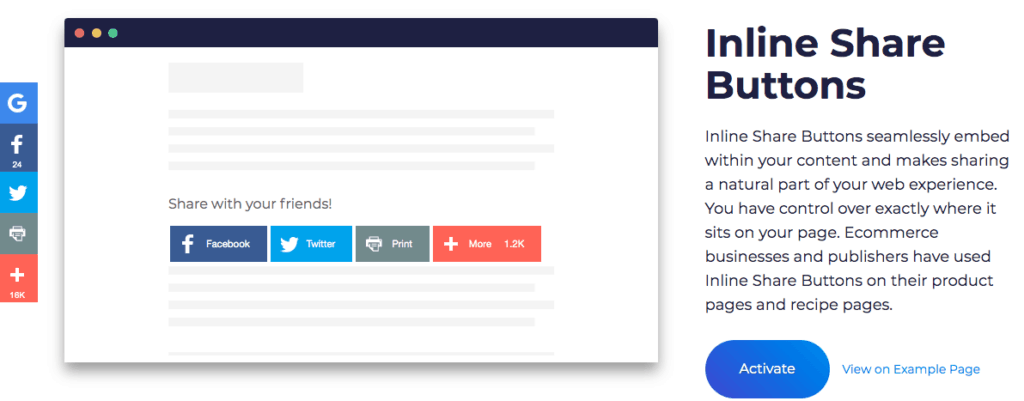
Besides gathering insight from experts and thought leaders to build trust, it also gives increases the potential of these people to share such articles, so you can leverage their audience to increase reach.
Build free tools and microsites
If you’re reading this article, chances are you know Hubspot’s WebsiteGrader.com

I’d argue writing good blog posts take time but help you stand out. However, I think free tools have more impact, and you can prove it below:
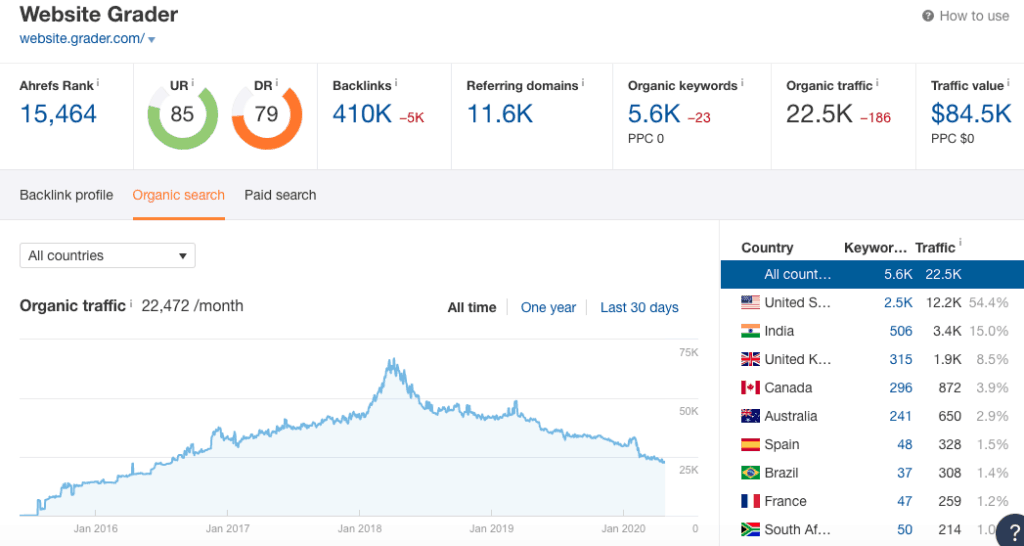
According to traction, Hubspot’s website grader has been used by more than 3 million websites.

This website grader is great not just due to raw exposure, it’s contextual to the kind of businesses Hubspot wants to reach.

Create Infographics with embeddable codes
To be honest, most long-form blog posts like this one are not meant to be entirely read.
These +5k word-long articles are intended to rank better on Google.
However, I’m sure a tiny percentage of page views translate into reading 100% of this article. I hope; however, you find useful most of the strategies and tactics shared here.
But in terms of actual engagement, visuals take the lead.
Infographics, dashboards, videos, and images —you name it.
For infographics, I personally like those sites which make them easy to share by dropping an HTML code below the infographic to make them embeddable.
So, it’s easy for bloggers looking for external links to add on their content, translating in more backlinks.

Create infographics that go viral
Besides backlinks, if infographics are fantastic, they have the potential to go viral and be featured on news media.
Some resume builder SaaS companies, for instance, use to create resume-infographics of famous people, like Elon Musk.
This one-page resume was featured on Life Hacker.

Another example is, Adioma, an infographic building software, used to create life-story infographics of famous entrepreneurs.

Some of them were worth a mention on sites like Market Watch.

Infographics don’t need to go viral to be successful.
You can resonate within a specific audience by sharing your content on relevant Subreddits, Facebook groups, and pitching to influencers.
Mint, another infographics company, promoted their product by telling stories that people wanted to read, instead of just showcasing their features.



Consider real-time dashboards as your next piece of content
While I’m writing this article, we’re in COVID-19 times.
Chances are you have seen this dashboard by the John Hopkins University.

I wanted to try something similar. I built a COVID-19 dashboard for Colombia.
In a few days, it reached more than 20k views. I’m going to show you this dashboard engagement metrics:
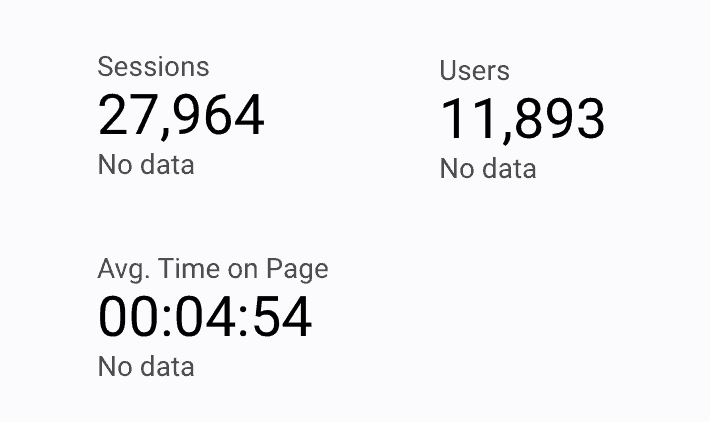

If you have experience with blogging, you should know that this kind of retention and engagement is seen in blog posts. 58% of traffic is from recurrent visitors and AVG. time per session is over four minutes.
To me, as data visualization platforms become more popular, part of the future of content marketing will be beautiful data visualization through real-time dashboards.
Just for the record, this COVID-19 dashboard drove a few but high-quality leads, like a big pharma company and a unicorn startup.
Write guest posts
I like guest posts because they’re a surefire to get a relevant backlink. It also helps your business leverage the reputation of the blog where you’re writing.
Something I do to find sites looking for guest posts is typing on Google “Write for us” + “marketing” to make sure Google shows you only the pages with those keywords. I recommend this Ahrefs blog post about Google search operators.

Leverage comics and cartoons
If you’re a marketer, you must know The Marketoonist, by Tom Fishbourne, a smart, experienced marketer that recognizes the problems and ironies we face daily.
While hard to execute, good cartoons may resonate within an audience, especially in the B2B world where we’re used to sober stuff.
A great example of cartoons and infographics is Toggl, copying 9GAG style but relating to productivity.

Image Source: https://blog.toggl.com/startup-zoo-comic/
Host an AMA
AMA stands for Ask Me Anything, and, if well done; it can be great to build trust and connect with your audience without preparing material.
It’s likely that if you’re an expert and have. A presentation, chances are attendees will have many questions to make. So, you may also prepare sessions for open questions.
During the pandemic, many public institutions are making efforts to help businesses to shift to digital and request consultant to help them out.
In the past, digital was a nice to have, now it’s a must—and most people are not used to research content online if you have expertise.
AMAs may work well if you already have an audience that trusts you and want to hear from you and your thought process. Otherwise, chances are people wouldn’t even commit to asking.
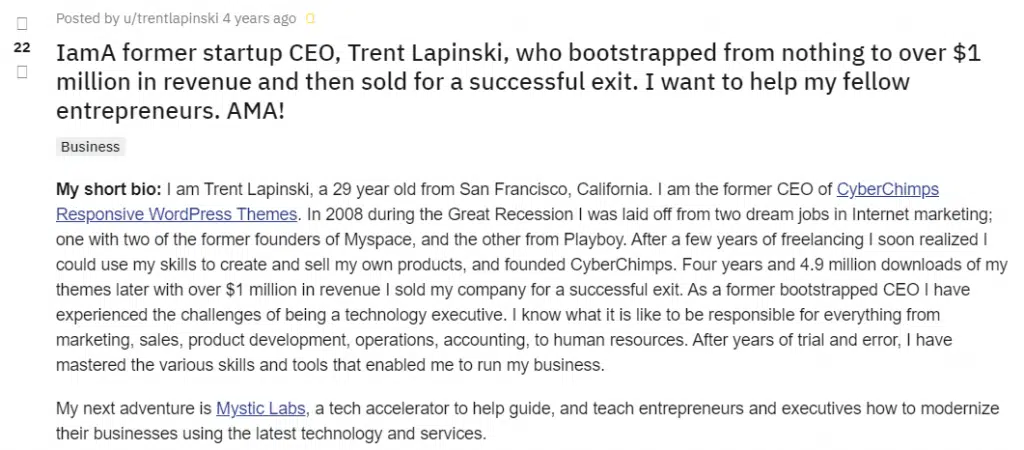
AMA’s can be hosted through online forums or live broadcasts.
A specific idea I’d give you is:
Reach out an institution or company with an audience of your interest and offer them to have an AMA for them.
Broadcast it on both Facebook Live and Youtube.
Use Manychat on Messenger to get Messenger subscribers every time someone comments your post.
Keep the conversation with a dedicated landing page where people can sign up to keep asking.
Many people may leave or won’t attend such AMA, but you can repurpose such content to have a new Youtube video or a set of mini videos for social media.
Answer Questions on Quora.

Quora is a social network to ask and answer where you can position as a thought leader while getting exposure. You may already know it and read about it, so here are some tips I would personally consider.
Don’t go after old questions where there are many answers with tons of upvotes. Outperforming them is hard.
People tend to upvote those who are already recognized. If someone asks a question about how it is to work at Google, the most upvoted answers will be from Googlers.
Don’t ask a colleague to ask “what is the best x software product” so you can answer. Unless what you say is useful, such a question will remain invisible.
Rank for hyper specific keywords on Google
I have shared this stat already in three of our articles:
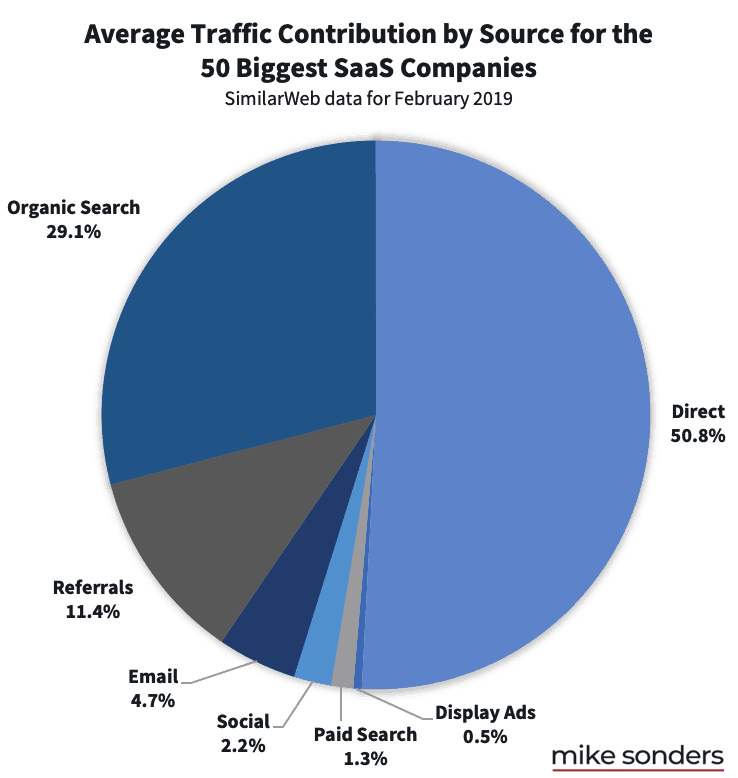
I know many may object it, but SEO may be your most important source of recurring traffic.
This time I won’t say why it’s essential, but the first things I’d try if your SaaS is getting started in SEO.
Go after the most commercial-intent yet long-tail keywords regardless of search volume.
Your priority when getting started is proving results as soon as possible, and, personally, the best way to convince a company to keep investing in such efforts is generating a low yet consistent source of high-quality links.
I have a website whose most essential product pages don’t get more than 100 visitors/mo.
However, during 2018 and 2019, it got leads from large companies. The reason is we rank high for super-specific keywords that only specific audiences would search but whose intent is high.
To give you an example, if I sold collaboration software, I would try to rank for keywords like “collaboration software for schools” or “internal chat for educational institutions.”
Even if search volume in tools like Google Keyword Planner, Moz, and Ahrefs will show zero search volume, such keywords may have a few searches a month, yet relevant.
The main lesson I’d give is optimizing for speed to get leads as soon as possible; going after competitive and high-volume keywords is not fast, especially when your site doesn’t have as many backlinks as current competitors.
Rank for a keyword with a product and a content page
Common sense may call this technique keyword cannibalization; you’re trying to rank for a keyword with two pages.
This recommendation is not based on a correlation study but on anecdotal evidence.
I used to rank for a specific keyword with a product landing page. But I considered that an in-depth guide would also help searchers’ intent, so I created a 2,000 long blog post around the topic.
As a result, such a guide started to get more traffic than the product page, but the product page didn’t lose traffic or impressions – so what did happen?
Frequent keyword reporting is limited. You can visualize keywords you rank for, but you can rarely understand the nuances or little variations of the queries.
Such modifications can transform the searcher’s intent – from purely commercial product research to an informational one.
This is why I’d urge you to consider ranking for a keyword with both product and content pages, separately.
Rank for competitors keywords
What is the highest commercial intent audience?
Your competitor’s customers.
Look at this example where the query clear says data studio and Supermetrics is paying for ranking for that specific product-search keyword.
Many of them are maybe looking for alternatives to their current provider, and you could rank for them.
In 2018, Microsoft made substantial shifts in its product strategy—ending up in churn.
When news of such updates was published, we created some Microsoft replacement or alternatives articles.
The result was that they became the essential piece of content and acquisition channel for the company: we attracted former Microsoft customers that wanted to switch to other solutions fast.
Such articles generated more than 1,000 visitors a month to the website, whose keywords were as expensive as $12 per click. It means that month we saved the company at least $12,000 they would have paid to get the same traffic on Google Ads otherwise.
How to rank for “X alternative?” Write a listed article showcasing your competitors but putting your brand first.
Another way to target competitors’ customers is by ranking for “X pricing”. It turns out that companies like Microsoft are so big that their pricing and features structure become inevitably complex.
So, you can consider ranking for “Microsoft X pricing” with an article that carefully explains your competitor’s pricing better than they do. It’s even better if your competitors don’t also have a pricing page – the chances are that more people will search for them on Google.
Write comparison articles
Another way to reach a high-intent audience is by targeting those looking for product reviews and comparisons.
G2Crowd and Capterra are reviews sites that tend to rank first for these keywords, but, personally, I think you can outrank them. Many of their pages ranking for product-review related keywords are generated automatically or generically—and they’re rarely precise and updated.
For instance, if you work within the project management software niche, you may write articles like:
- Asana VS Basecamp
- Bitrix24 VS Trello
- Monday VS Asana
You can see many companies do this already.

Chanty, a team chat app, does something like this…

Just like Chanty, you can leverage such traffic to encourage them to give your product a try.

Leveraging push notifications
9 out of 10 times I suggest push notifications as a tactic to convert visitors into users, there’s a negative answer – they associate it with spam. I agree.
I’d proceed to push notifications with caution, and once your company culture truly cares about providing value through content.
Among a few examples of companies, I consider that leverage push notifications successfully are Platzi and Product Hunt.
It makes total sense for Product Hunt to use push notifications — they’re meant to promote new products as they come.
On the other hand, Platzi, the largest education platform for the Hispanic market, has a live broadcast with free online classes and keynotes that they publish religiously on Tuesdays and Thursdays that gather thousands of loyal viewers.
Platzi publishes push notifications at the moment when their live broadcasts start.
Email marketing good examples
We all talk about email marketing – I can mention a few examples that I find valuable and remarkable.
Just as a personal example, I consistently see that automated emails after signup or content download have decent open rates:
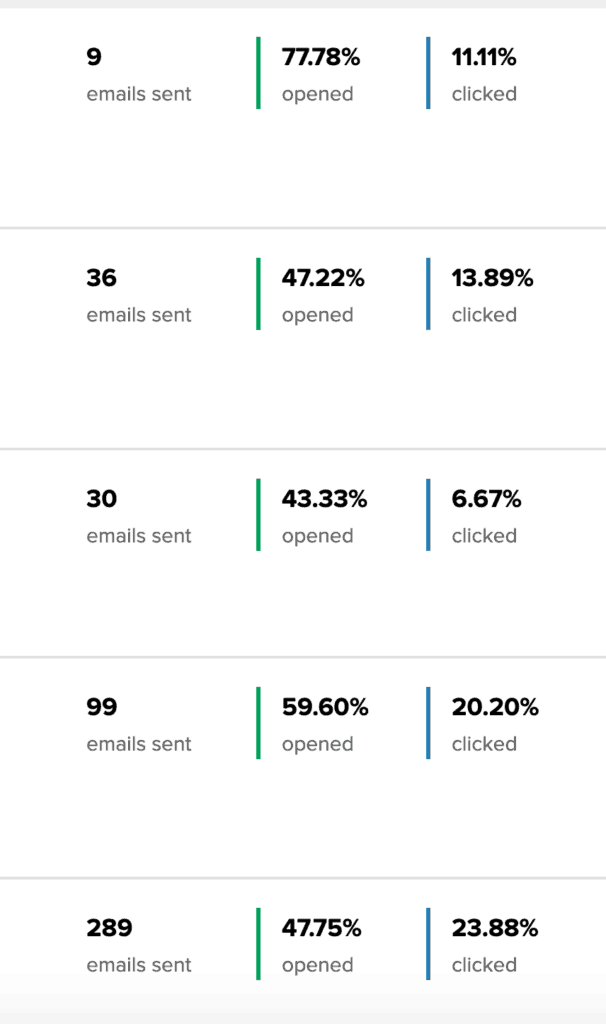
As a brilliant example, Zapier is one of the few companies whose product updates emails are worth opening. The reason is they have a product people love, and each update means a potential use case to automate something.

Atlassian, for instance, sent me this email a few hours ago:
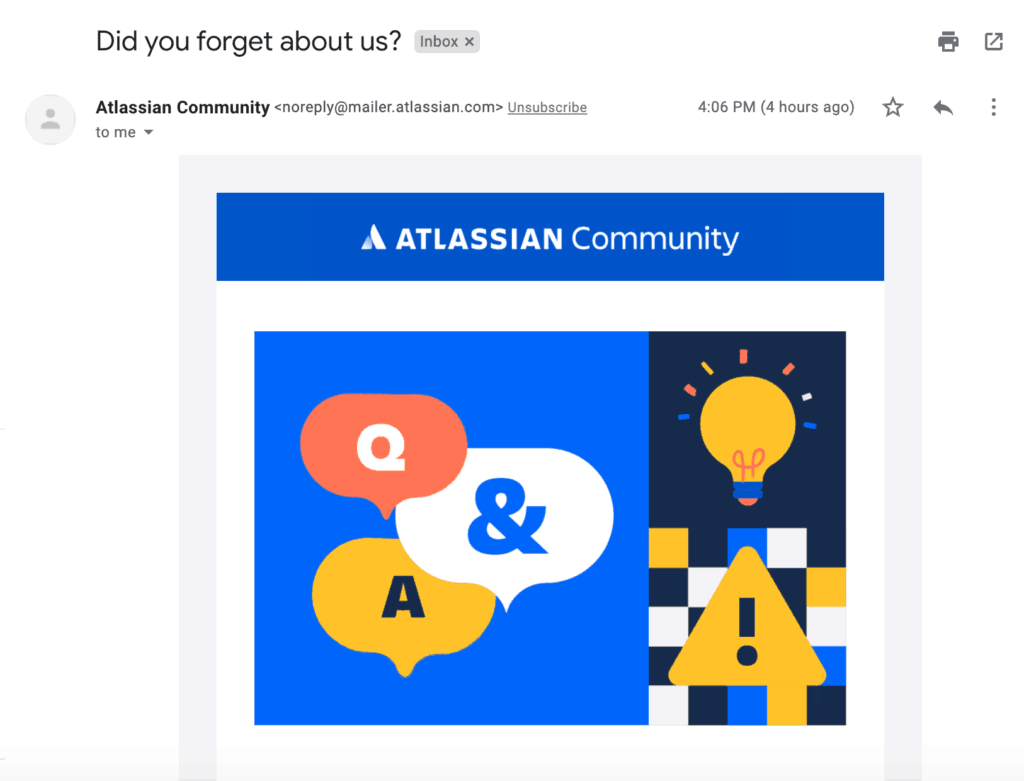
I signed up for their free account and haven’t been active for more than a week. While I’m not converting right away, they’re encouraging me to join the Atlassian community, which I haven’t joined yet.
Here we highly recommend Manychat; we let you a blog post where you can have some examples on how to use this tool.
And finally, my favorite email marketing example: the goodbye email from Hubspot.
It is not a high-converting copy that turns me into a customer instantaneously (it rarely works that way). I just need to say I love this smart, humble approach to give a good experience even when a user is leaving.
Making signups frictionless
The idea behind allowing users to sign up through Facebook, Gmail, or whatever 3rd party service is to ensure your users are giving real emails and, more importantly, they can sign up fast.
The foremost step to convert a visitor to a user or a free trial is the signup form. It is also the one with the highest friction because it’s meant to provide value to the marketer, not the user.
And users associate types with future spammy emails. Filling a form and setting a new password (and setting it again) is “excruciating” pain for many users. It’s not a big deal when people are eager to try your product, but the chances are that most of them don’t even know it well—and the might leave at the first sign of poor UX.
Leverage SaaS Review Sites (if you have the money)
I contacted Capterra once to know how much they charge for ranking a product on top of their list.
Their pricing model was simple. The higher you’re on a list for a specific product category, the more you pay per click. And you pay per click your product gets.
It was quite a funny moment when I had a video meeting with one of their sales reps, and he used their pricing calculator to give me an estimate of how much we should pay to get some high-quality clicks on their site.
The recommended CPC was at least $8, not to rank first, but to be shown somewhere in the list. We both laughed, and he agreed that it was expensive; it was a valuable niche.
Many companies can afford to pay these budgets, but most of them don’t.
You can also leverage these reviews sites for free by asking your current customers to upvote your product on them. However, to get the best output, chances are you must pay.
Referral programs work when your product doesn’t suck
Many marketers talk about referral marketing like it was a risk-free source of passive income and customers.
Like it was a surefire, set-and-forget tactic.
However, it doesn’t work for most businesses. Why?
Besides decent referral programs incentives, your product needs to be worth sharing and broad in terms of use cases that are suitable for content and tutorials.
It seems common sense, but I hesitate boring products in boring niches that can leverage massive value from Word of Mouth. While virtually all businesses need to build reputation and trust through reviews, not all can leverage a system where people can get paid for recommendations.
Hosting companies and popular products like Manychat were people were already sharing before they had a referral program are good examples.
Read more: Affiliate Marketing: A complete Newbies (and skeptics) Guide for 2020
Belong to and own Facebook groups
I love Facebook groups. I belong to some of them that are truly valuable. I have insightful conversations and learn things that I wouldn’t look for on Google or Youtube.
It’s also a great place to connect personally with other companies and individuals.
From a user perspective, Facebook groups may be the best channel to see product reviews.
At least once a week, I see posts of people asking for product recommendations full of comments from actual users.
I’ve acquired customers on Facebook group without an actual commercial intent.
I like to answer, ask, and help. Sometimes those answers end up on Messenger conversations that end up on projects and new contacts.
I understand that having conversations on social media is not an excellent solution; it doesn’t require a Zap or web scraping, keyword research, ads, remarketing, or any sophisticated form of automation.
It’s just about commenting and talking when you have something valuable to say and share.
Functional groups don’t accept spam or promotions, but they support valuable content.
Besides belonging and interacting on Facebook groups, it’s also nice to consider having your Facebook group. Benefits include:
Reach is higher than a page (and I’d say relatively better than ads).
You can visualize whom you’re reaching.
You can interact more efficiently and share recurrent content better than email. I’d value more Facebook group members than email subscribers as I have a better chance to interact with them within groups.
You can share polls, contests, and leverage community support around your product.
There are three great examples of well-done Facebook groups that create a community and are a great source of inspiration and support through user-generated content.
One great example is Manychat, probably the best Messenger chatbot builder, whose Facebook group is composed of people sharing their chatbot templates and tutorials, just like the one below:
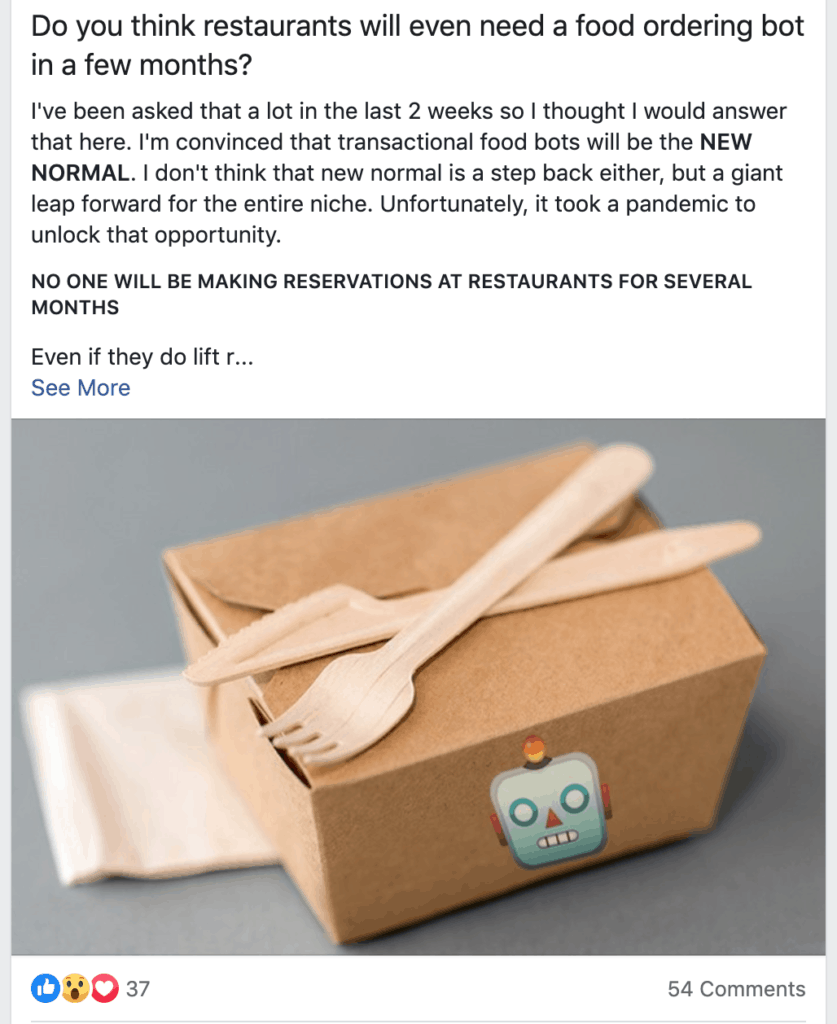
Lemlist, a personalized email automation solution, believes so much in Facebook groups that they even show it on their homepage.
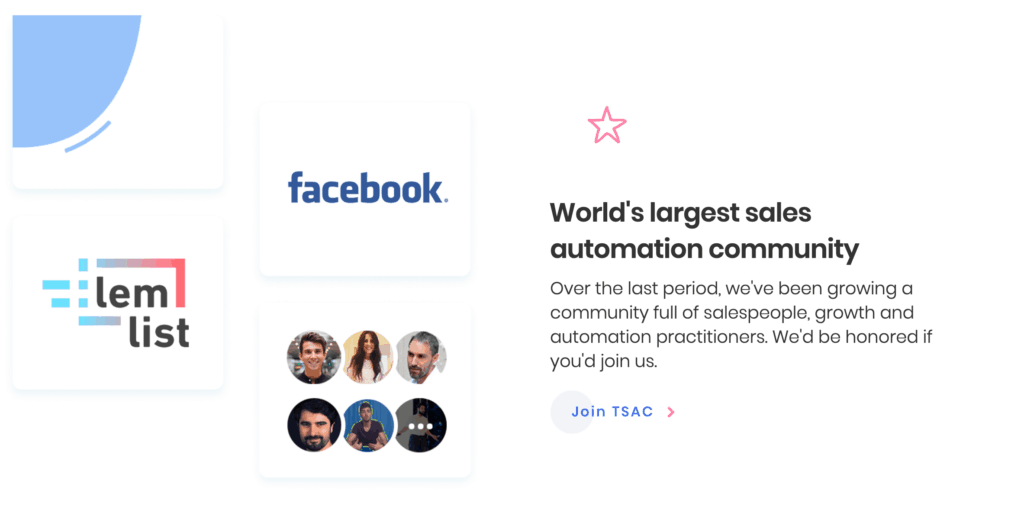
And finally, Elementor, the most popular site builder for WordPress, where members share tutorials and examples of their latest work that many take as inspiration for future web design.
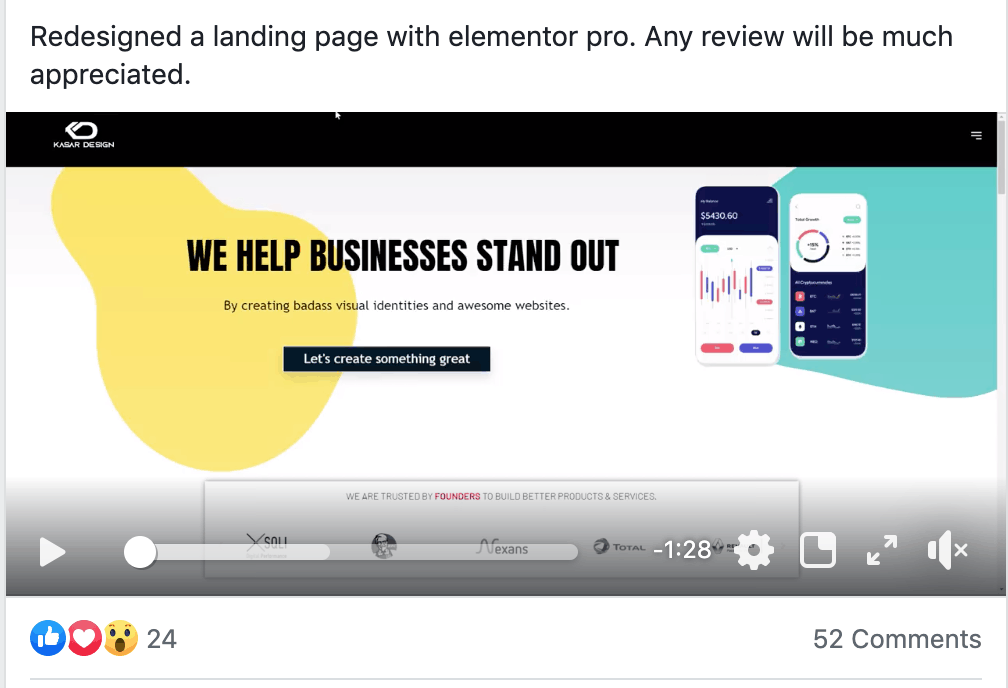
Become more personal with screen and face recordings
I take the opportunity to connect with people on the internet personally.
Part of my SaaS marketer mindset is that your most valuable asset is to build trust.
I don’t think a lot of growth hacks and automatic tricks as the default way to grow. To me, those are tactics or channels, but overall, all technology is a means to build trust —to make people like you.
And tools like Drift Video, Bonjoro, and Loom help you doing exactly that.
These tools let you send personalized videos to your customers and leads.
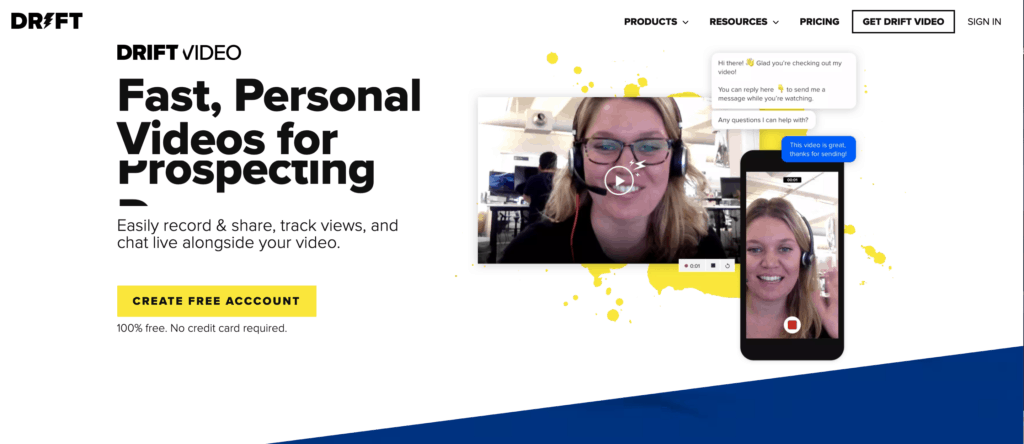
To me, these personal videos are a great, unexplored way to present a product, send a proposal, or simply connect in a unique way.
Build a use cases library
A unique challenge SaaS marketers face is that we market abstractions.
The features we offer are visualizations, databases, forms, formulas, automation in general.
But the benefits and use cases are incredibly variable.
When you’re a full-time employee, you can become biased and see your product too evident that everyone should quickly understand it.
But chances are people don’t understand your product, they don’t know how you’re different, or don’t even know they would use it.
A great example is Airtable, and this BBC article is an excellent example of such abstraction.
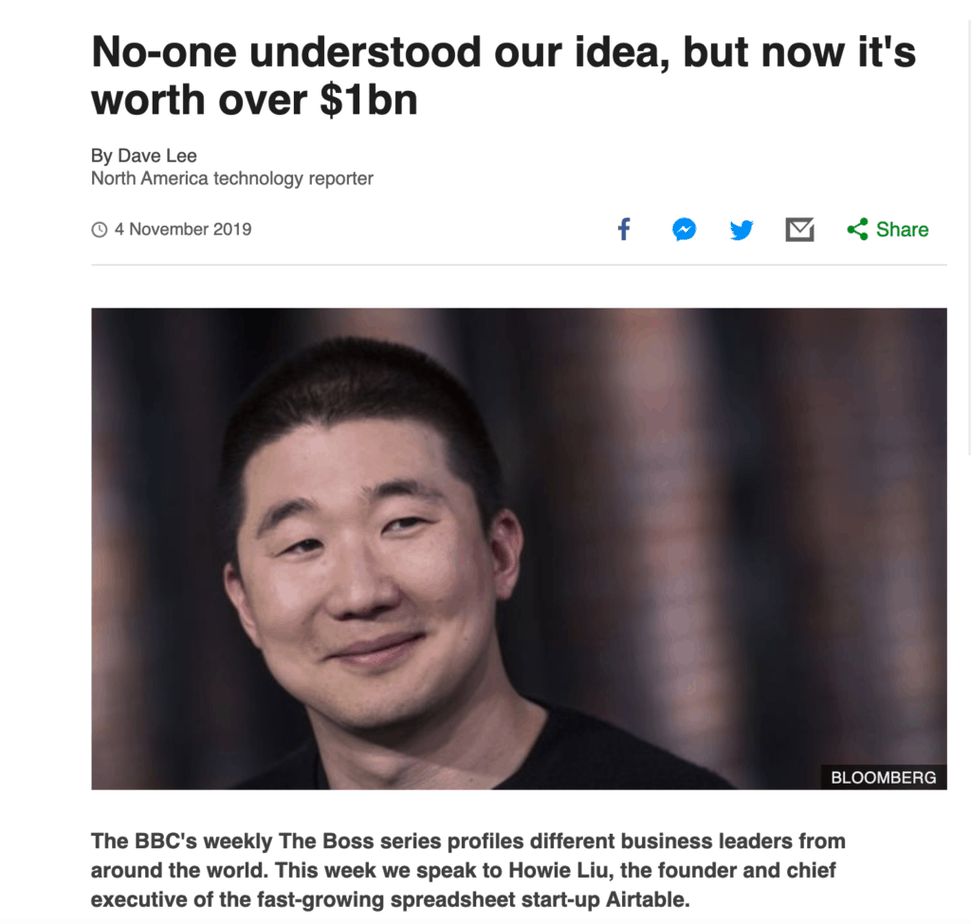
Spreadsheets, tables, rows, and formulas are not sexy. Nobody—unless you’re an authentic nerd— gets excited about the idea of “richer spreadsheets.”
But things like time tracking apps to measure productivity, content calendars to document a strategy, sales tracking performance, and surveys may sound more exciting (a little bit, at least).
What is curious is that this set of apps—and virtually most apps— require the same features.
Unless you’re technical, you don’t think of software with features but use cases.
Showcasing use cases and examples about how people can use your product to solve a problem may be the best to communicate your SaaS.
For Airtable, such approach transform their “richer spreadsheets” to a gallery of possibilities:
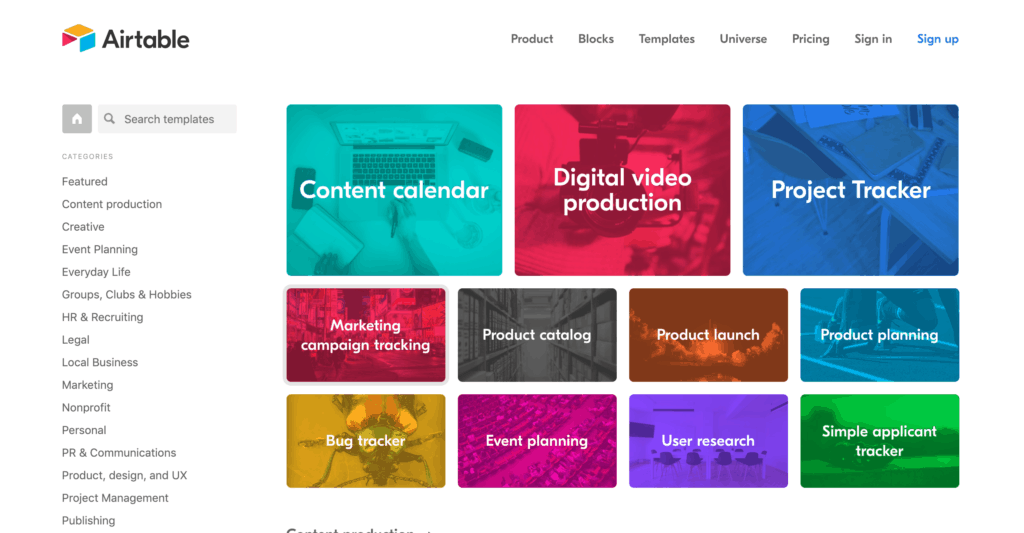
Make sure you have a page in your menu with ideas and examples of things that people can do with your products.
Product tours for user onboarding and activation
A great tactic I encourage businesses with complex purchase processes is leveraging animated product tours.
Tools like Userlane could help your users get started with your product or meet a new feature better than a detailed step-by-step guide or scheduling a personalized walkthrough.
Since you’re here
Did you like what you read? Here are more suggested articles:
- Product Managers’ daily Responsibilities, Metrics, and Tools
- Product strategy: +10 ways to shape your product roadmap
- B2B Marketing Strategy: An Actionable Guide in 2020
- 20 Project Management Software (curated for digital businesses, marketers, and developers)
- Growth tips for 2020 – experts roundup at Pitchground’s Growth Summit




